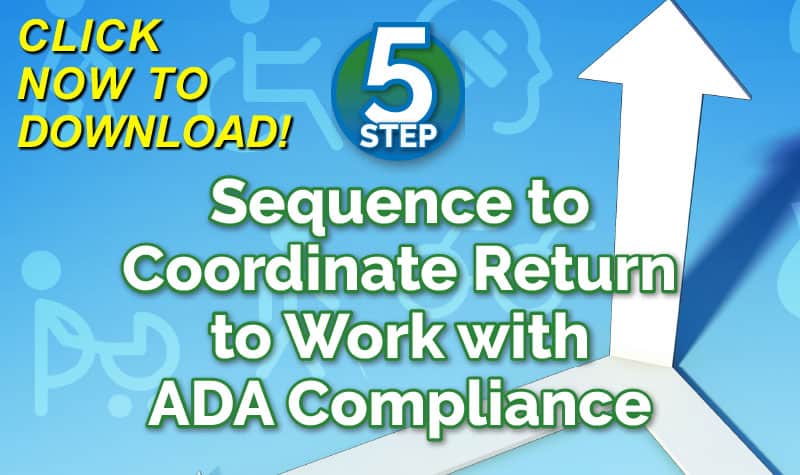Interested stakeholders in any workers’ compensation program need to be aware of the many issues when it comes to running an effective program. One of those includes being aware of how the American with Disabilities Act (ADA) impacts their program and post-injury efforts to return an employee to work. Failure to do so can result in fines, penalties and lack of good will. Now is the time to pay attention and prepare.
What is the American with Disabilities Act?
The ADA was passed was signed into law in 1990 as an amendment to the Civil Rights Act of 1964. The law prohibits certain discriminatory practices based on an individual’s disability. The law was amended one most recently in 2008, when President George W. Bush signed amendments to the law that expanded the scope of the ADA to include additional areas of coverage.
Click Link to Access Free PDF Download
“5-Step Sequence to Coordinate Return-to-Work with ADA Compliance”
Important matters to consider in the context of workers’ compensation claims include the following:
- Disability: This is defined by the statute to include “a physical or mental impairment that substantially limits one or more of the major life activities;” and
- Qualified Individual with a Disability: The ADA only applies to an “individual with a disability who, with or without reasonable accommodation, can perform the essential functions of the employment position.”
How Does the ADA Apply to Work Comp?
The ADA impacts workers’ compensation once the threshold issue of the law’s mandates are met. This occurs when the injured employee is considered “qualified” for protections under the Act by demonstrating a reasonable accommodation may be needed in order to perform the essential functions of their job, or a return to work job offer.
Consider the following:
- The definition of ‘disability’ includes “…substantially limits one or more major life activities.”
- A major life activity under this definition includes the ability to work at full-duty.
The need for a reasonable accommodation can apply both when an employee returns to work in their pre-injury position, or in a modified capacity. Failure to make these reasonable accommodations can subject the employer to a variety of penalties and fines.
Effective Work Comp Claims Handling Consistent with the ADA
The first step employers can take in effectively managing their workers’ compensation programs is the consistent application of employment matters to all employees. This includes the following:
- Have a dedicated in-house point of contact on all ADA and other employment law matters. This will likely be someone in human resources, who is familiar with workers’ compensation and other disability-related issues. Utilize legal counsel when necessary to avoid problems by being proactive.
- Document every employee’s workplace conduct and performance on a consistent basis. This includes the consistent application of punishment for workplace violations, including termination. This can become an area of concern when an employee arrives late for a scheduled work shift, or does not notify the employer of an absence.
- Conduct a roundtable discussion with internal interested stakeholders including the injured worker for a discussion known as the “interactive process” before offering an employee covered by workers’ compensation and the ADA a return to work job offer.
- Document the necessary requirements of all available positions within the place of employment. This should include the essential functions of a job, the necessary physical requirements and workplace safety issues. An assessment should also take place as to whether an employee with certain disabilities can be “reasonably accommodated.” This is a legal standard, not a matter of one’s personal opinion.
Conclusions
It should be the goal of every employer to return an injured employee back to work. This is sometimes not only a question under the workers’ compensation law, but one that includes ADA considerations. Interested stakeholders need to understand these matters in order to promote a safe workplace and reduce unnecessary expenses.

Contact: mstack@reduceyourworkerscomp.com.
Workers’ Comp Roundup Blog: https://blog.reduceyourworkerscomp.com/
©2018 Amaxx LLC. All rights reserved under International Copyright Law.
Do not use this information without independent verification. All state laws vary. You should consult with your insurance broker, attorney, or qualified professional.










